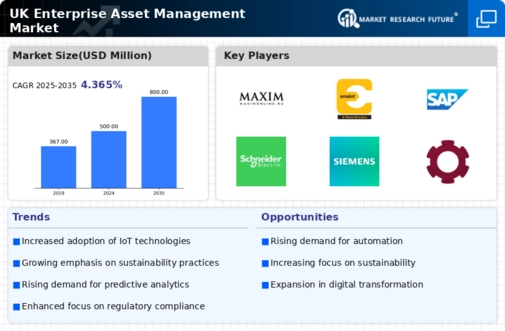Increased Focus on Operational Efficiency
In the enterprise asset-management market, there is a growing emphasis on operational efficiency as organisations seek to maximise their asset performance. Companies in the UK are increasingly investing in asset management solutions that provide insights into asset lifecycle management. This focus is reflected in a 30% increase in the adoption of enterprise asset management systems over the past year. By leveraging these systems, organisations can identify inefficiencies and implement strategies to enhance productivity. The drive towards operational excellence is further supported by the need to reduce downtime and maintenance costs, which are critical for maintaining competitiveness in the market. Consequently, Businesses prioritizing efficiency in their asset management practices position the enterprise asset-management market for growth.
Regulatory Compliance and Risk Management
Regulatory compliance and effective risk management significantly influence the enterprise asset-management market. In the UK, organisations are increasingly required to adhere to stringent regulations regarding asset management practices. This has led to a surge in demand for solutions that facilitate compliance tracking and reporting. Recent data indicates that 40% of UK companies have upgraded their asset management systems to ensure compliance with industry standards. Additionally, the focus on risk management has prompted organisations to adopt comprehensive asset management frameworks that mitigate potential risks associated with asset failure. As regulatory pressures continue to mount, the enterprise asset-management market is likely to see sustained growth driven by the necessity for compliance and risk mitigation.
Growing Demand for Sustainability Initiatives
Sustainability has emerged as a critical driver in the enterprise asset-management market, particularly within the UK context. Organisations are increasingly recognising the importance of sustainable practices in asset management, leading to a shift towards environmentally friendly solutions. Recent surveys indicate that 35% of UK businesses have implemented sustainability initiatives in their asset management strategies. This trend is not only driven by regulatory requirements but also by consumer demand for responsible business practices. As companies strive to reduce their carbon footprint and enhance their corporate social responsibility, the enterprise asset-management market is likely to expand, with a focus on sustainable asset management solutions that align with these goals.
Technological Advancements in Asset Management
The enterprise asset-management market is experiencing a notable shift due to rapid technological advancements. The integration of advanced software solutions enables organisations to optimise asset utilisation and streamline operations. In the UK, the adoption of predictive maintenance tools has increased, with a reported growth of 25% in usage among large enterprises. This trend indicates a growing recognition of the importance of data analytics in asset management. Furthermore, the implementation of mobile asset management applications allows for real-time tracking and management, enhancing operational efficiency. As organisations increasingly rely on technology to manage their assets, the enterprise asset-management market is likely to expand, driven by the need for improved performance and reduced operational costs.
Shift Towards Integrated Asset Management Solutions
The market is witnessing a shift towards integrated asset management solutions that provide a holistic view of asset performance. In the UK, organisations are increasingly seeking systems that combine various functionalities, such as maintenance management, inventory control, and compliance tracking. This trend is evidenced by a 20% increase in the adoption of integrated solutions over the past year. By consolidating asset management processes into a single platform, organisations can enhance visibility and decision-making capabilities. This integration not only streamlines operations but also supports data-driven strategies for asset optimisation. As the demand for comprehensive asset management solutions grows, the enterprise asset-management market is expected to thrive, driven by the need for integration and efficiency.





















Leave a Comment